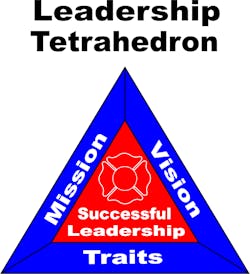Great fire departments don’t just happen by chance, they are developed and refined over time through years of successes and failures. The same holds true for the people who seek to be leaders in their organizations. The good news: We will always need a fresh supply of leaders to keep the fire service moving forward in a positive direction. The truth is, leadership is more about attitude and action, and less about rank, tenure or educational status.
There have been many great articles written on leadership from some of our best-known fire service mentors across the country. We should treasure those “golden nuggets” of information they have provided us and use them for future personal and organizational development and improvement. This article takes a different approach to leadership using one of the fire service’s most basic fundamentals—the fire tetrahedron.
When we first started our fire service training as rookies, we were taught the fire triangle—fuel, oxygen and heat—which eventually evolved into the fire tetrahedron with the addition of the resulting chemical chain reaction that leads to sustained fire burning. Similarly, we can think of leadership as having three main components—traits, mission and vision—which create a resulting formula for effective leadership, making a Leadership Tetrahedron.
4 steps to success
As stated earlier, leadership has no boundaries, and we can choose to accept the challenge to become a leader at any point in our career, starting with the first day we show up for the fire academy. Some of the best leaders I have had the privilege to work with and watch over my career have been seasoned company officers, but most have been just great firefighters working in the trenches each shift setting the example of “true leadership.” For example, they are the first ones to show up for their tour, always squared away, displaying a positive attitude, and eager for knowledge. Every fire department has these progressive individuals who stand out.
With this in mind, let’s take a closer look into the Leadership Tetrahedron and see how it applies.
Leadership traits: A successful leader is consistently honest, demonstrates integrity with character, and inspires others to accept new challenges. They focus more on collaboration than personal achievement, turning the spotlight on others instead of themselves. Successful leaders have the willingness and ability to challenge the “norm” of daily operations and look for ways to be creative and innovative at the same time. Being a successful leader often means taking calculated risks despite being questioned by others, knowing that the interest of the organization and safety comes first. Consider this example: A citizen is involved in a motor vehicle collision and needs to be transported to a local hospital. A firefighter recognizes that her purse and groceries are still in the damaged vehicle and brings this to the attention of his officers. The purse is secured and given to the ambulance crewmembers, who eventually give it to the patient at the hospital. The groceries are delivered by the engine company to a family member who lives nearby shortly after clearing the scene. Family and patient are very thankful for the extra effort.
Mission-critical thinking: Successful leaders don’t wait for things to happen but set the pace for the future by focusing on the mission of the fire department. They make sure the daily mission gets taken care of and are always on the lookout for new opportunities to expand their horizon and inform others. Successful leaders don’t hoard information but rather make it a standard practice to include and educate everyone on the team, taking a “we are in this together” approach. Whether the mission is at a personal level, company level or organizational level, the focus is the same—to get the job done in a safe, logical, timely and efficient manner. It could be said that successful leadership means taking care of business one shift at a time. Here’s an example: The station officer makes it a point to be outside and involved with his crew each shift whether it’s helping to clean the rig or taking the lead on training his crew about a new hose deployment evolution he just learned from attending a regional fireground tactics course. By doing this, the crew gains confidence in themselves as well as in their officer.
Vision: Successful leaders have vision; they are always thinking ahead of the game, playing out possible scenarios that don’t just benefit themselves but the entire fire department. Leaders can establish and articulate their vision with both short-term and long-term goals and objectives all firefighters can comprehend and buy into. This mental template keeps us organized and focused on the future. It is fair to say successful leaders demonstrate “inclusive leadership” on a regular basis. One example: A driver/operator recognizes the benefits of a comprehensive wellness program after suffering a heart attack while on duty. He takes the lead, conducts research, and puts together a presentation for chief officers to evaluate for future implementation. Everybody wins in the long run.
Successful Leadership: When you combine all the components of traits, mission and vision, most of the time the result is successful leadership. It’s important to remember that leadership is a learned behavior that you must want to engage in but is available to every firefighter.
In sum
The Leadership Tetrahedron provides a visual picture to which all firefighters can relate. Get involved, make a personal “leadership plan,” and position yourself close to successful leaders currently in your organization. Challenge yourself to embrace the Leadership Tetrahedron principles starting today. Let’s get to work!
About the Author
Les Ruble
Battalion Chief
Les Ruble is a 28-year fire service veteran and currently a battalion chief with Plano, TX, Fire-Rescue. He began his career as a firefighter in the U.S. Air Force. He has an associate degree in fire science and is a certified Master Firefighter with the Texas Commission on Fire Protection.
